Galangal is a staple herb in Thai cooking and other Southeast Asian cuisines. I use it often in my recipes, but a lot of people are confused by it. So in this article we will cover everything you need to know about galangal, including what it is, how to use, choose, store, substitute and more!
PREFER WATCHING A VIDEO THAN READING? Check out my galangal 101 the video below, but note that the text version is a bit more detailed.

Want to save this recipe?
What is Galangal?
Galangal is a tropical perennial herb, and while many people call it galangal root, the part of the plant that we use for cooking is actually the rhizome. Rhizome is a type of underground stem, and from it, the roots and shoots come out. When you buy galangal, you can see little dots where the roots used to be.

Galangal is called kha in Thai. If you've ever had Thai curries, you've had galangal because it's a key ingredient in our curry pastes, such as this green curry paste, as well as in popular Thai soups such as tom yum (hot and sour soup) and tom kha gai (chicken and coconut milk soup). Sometimes, I've heard it referred to as Thai ginger or Siamese ginger.
Wanna learn more about Thai ingredients? Check out my other Thai ingredient deep-dives here.
Ginger vs Galangal
Many people confuse fresh ginger for galangal because they are both aromatic rhizomes with a similar shape. But side by side, you can see that galangal is smoother and paler than ginger. It also doesn't have much of a skin and doesn't need to be peeled. And despite what some people suggest, I maintain that ginger is not a good substitute for galangal. Ginger has a hot and spicy flavour, while galangal has a cooling, refreshing aroma.

Now, if you used ginger in place of galangal the dish will turn out fine, and it might even taste great, but the flavours will not be the same. It's like substituting basil for mint. Will your dish be ruined? No. Does it taste the same? No. So if you're gonna make the substitute, just know that going in.
What Does Galangal Taste Like?
Galangal has a wonderful cooling woodsy aroma that reminds me very much of a lush pine forest. You might say it has a slightly medicinal flavour (in a good way) because it's nice and refreshing, and kind of reminds me of Vicks!
If you were to chew a piece of galangal, it's not pleasant. It's very tough, a bit bitter and too pungent to enjoy. So we use galangal only for its aroma, and often, for infusion only and the pieces are discarded. If it is to be consumed, it has to be pounded into a paste or very finely chopped. Very much like cinnamon sticks!
3 Ways to Use Galangal
- Infusion. Use a strong sharp knife to slice it up into thin pieces, then add them into a simmering broth and let it infuse for at least 3-4 minutes, after which you can discard the pieces, or leave them in the soup but tell guests not to eat them as they are very tough.
- Pounded into a paste. This is very commonly done in Thai cooking. We pound galangal into many of our curry pastes, but you can also make a general herb paste and put it in a sausage mix or in a stir-fry. Use a mortar and pestle to pound, but be sure to finely chop or thinly slice it before pounding so it will break down more quickly.
- Finely chopped. This is less common, but you can chop it finely, and then add it to salads, dips, stir-fries...or really anything! For example, you can add finely chopped galangal into a laab. Make sure it is fine though, as too-large pieces will be too tough and pungent.
Different Varieties of Galangal
A word of advice: don't worry about getting the right type of galangal. Why? Because 99.9% of the time the only one you can buy at Asian grocery stores IS the one you want (though some might be labeled incorrectly). A search into varieties will only end up confusing you. What's with greater galangal, lesser galangal, black galangal...?
Here's my attempt to simplify things: There are several aromatic rhizomes belonging to the ginger family that might be associated with the name galangal (or galanga, or galingale), however, in cooking there are only really 2 types you need to be concerned about:
- The "regular" galangal, which is the herb we're talking about. This is what people talk about when they call for "galangal" in their recipes, and this is likely the only one you can buy from the store. For nerds among us who really want to know, this is technically Alpinia galanga.
- Fingerroot, also known as Chinese ginger. In Thai we call this grachai or krachai, and sometimes, brined fingerroot you can find at Asian stores is mislabeled as "pickled galingale" and causes confusion. It is used occasionally in Thai cooking, as in this jungle curry or sour curry. Fingerroot looks like...well...fingers! Its aroma entirely different from galangal. Scientifically this is Boesenbergia rotunda.

Other varieties associated with the name galangal is used mostly in traditional medicine and is not something you can buy at your grocery store, so nothing you should worry about.
Health Benefits of Galangal
In addition to being a common culinary herb, galangal is considered to be medicinal in traditional Thai medicine and has been consumed as part of a healthy diet for thousands of years. There is some scientific evidence for its medical benefits, but please note that these were done in small studies and more research is still needed to confirm their effectiveness in humans.
- Galangal has been found to have antifungal properties with some success in treating skin fungal conditions. Many Thai herbs and spices are anti-fungal and this is probably a reason why curry pastes never seem to get moldy in the fridge even after many months!
- Some evidence shows that galangal has antibacterial properties against food borne illness bacteria such as E. coli. Again, this likely contributes to the longevity of food made with curry pastes.
- There's some evidence to show that galangal is anti-inflammatory and may help with pain associated with inflammation.
- In laboratory, extracts from galangal have shown to be effective against cancer cells, but this has not been done in humans.
Here's my source (if you can read Thai).
Substitutes for Galangal
As mentioned, many people will tell you to use ginger as a substitute, but that's like saying you can use rosemary instead of basil. Sure, you CAN use it, but the flavours are totally different. For me, ginger is not a good sub for galangal, and unfortunately nothing else tastes like it.
So if you can't find fresh galangal, your best bet is to find alternative forms. Frozen galangal should be your first choice, though choose frozen slices rather than frozen whole pieces because the whole piece is very hard to work with. Let it thaw just until you can take what you need from it; if it thaws completely it'll turn mushy.
There is also galangal paste available at some specialty stores, which is easy to use as it mixes well into a lot of things and has good flavour. Dried galangal pieces work well enough in soups, it just needs more time to infuse. Galangal powder exists but it's not a great substitute for fresh as the flavour is different, but I've seen people use it just to add some interesting flavour notes to various things, so it's worth experimenting with.
How to Store Galangal
Galangal will be fine in the fridge for a few days, but if you don't have immediate plans for it, the best way to store galangal is to freeze it. But don't just put the whole thing in the freezer or you'll end up with a hard lump that is only good for throwing at someone you're mad at. Here's what to do:
- Wash and dry it thoroughly, then thinly slice into rounds about ⅛ inch thick.
- Line a tray with parchment paper and spread the galangal slices in one layer and freeze. You want to freeze them in one layer otherwise they will stick together and become a pain to use. If you have a lot, stack them on the tray with parchment paper or plastic wrap in between each layer.
- Once they are frozen, work quickly and consolidate them into a freezer bag. Remove as much air out of the bag and freeze. This will last up to 3 months before they develop freezer burn. For longer term storage, wrap the galangal in aluminum foil before putting them in the freezer bag. Aluminum foil is will prevent freezer burn for longer than the freezer bag alone.
Recipes Using Galangal
Ready to start cooking with galangal? Here are some easy galangal recipes that are a great place to start:
Video: The Ultimate Guide to Galangal
If you prefer to watch, here's the original video with all the basics you need to know plus you can see it in action. But note that there is more detailed information in this article.

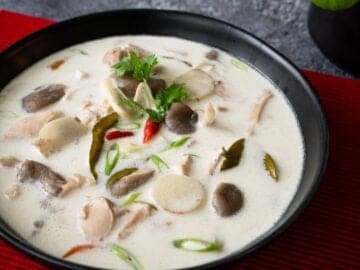
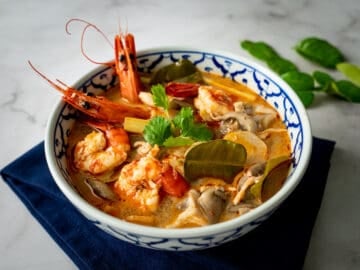
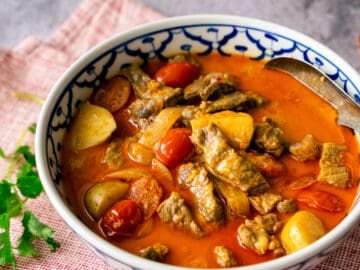
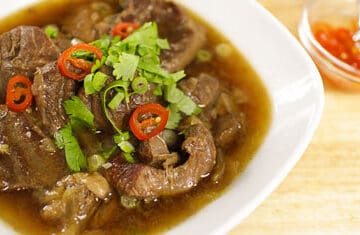

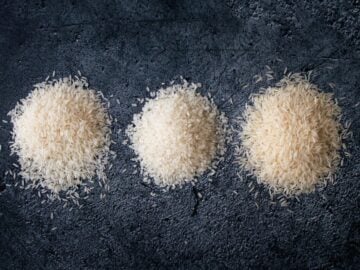
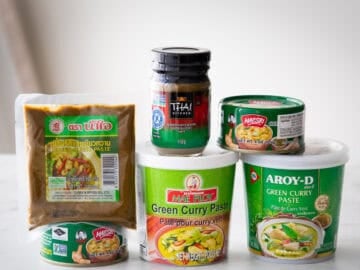
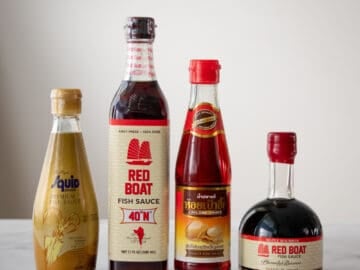
Mark Elf says
Freezing anything in a frost free freezer is not going to last very long. These types of freezers self defrost every time the "frost sensor" senses frost, it raises the temperature just above freezing. As the temperature is raised the frost changes into droplets and the fan draws the moisture out of the freezer and is evaporated usually in a small pan near the compressor at the bottom of the refrigerator or freezer. Each time this cycle happens it is defrosting the outside of any food stored and to make matters worse if there is oxygen in the food bag it's wrapped in you'll see Oxidation or commonly called freezer burn Storing food for any length of time requires a manual defrosting freezer. Most of these types of freezers can be set to 0 or below Zero and will never ruin food stored in them. The most important thing is an airtight seal. If you can afford one the best way to vacuum seal food is with a chamber vacuum sealer which is costly but worth every penny if storing food for the "long haul". I use the VacMaster 215vp. I like to use 4 mil bags which can be purchased for about 7cents per bag when you purchase 1000. Hope that helps.
Mehx says
Hi love,
Where do you get your galangal from? I am from Toronto, I tried looking everywhere but couldn't find it in any of the asian stores like Fu Yao, H mart etc.
please help. 🙂
Terria L. Grant says
where do you get the fresh ingredients for Tom Yum? I live in a rural Montana town and don't have access to fresh herbs.
Pailin Chongchitnant says
I'd check out online sources, importfood.com and also check out this map and see if there's a store near you. https://hot-thai-kitchen.com/locate-a-thai-grocer/
Kate Daneluk says
You can get fresh galangal from Amazon, but it is about $24 a pound! I did it once for some Indonesian recipes. I'm thinking of asking our local Thai restaurant if they'd sell me some.
Jason says
I have 1 plant I bought last spring in a 4" pot. It is now 7 months later and I feel it is time to check out the roots. Nice and clean, plus I have lots more plants now that I can pot up!!!
We really enjoy a lot of tea. I have used the leaves for tea, but not the root. Can I make tea from the root? I see a lot mentioned about the roots, but very little about the leaves. Do they have any other use?
Thank you!!!
Iris says
Hi Pai,
I was today in an Asian grocery store,
And I was curious to buy pickled galangal.
Now at home I tried to find recipes with this product but didn't find any...
Do you have any ideas for recipes with pickled galangal?
Elaine says
Wonderful article Pai! You said you are here to demistify Thai cooking and I would have to agree that I feel like I am off to a good start. I really want to get good at cooking Thai food, and I think your websites and articles will help me do that. Thank you!
Carol McCollum says
Would it be possible to grow galangal in the garden? I live in San Diego California. I have Makrut lime tree and other citrus trees in my yard. I can grow lemongrass and ginger here!
Pailin Chongchitnant says
It's definitely possible!
Alana says
When is the right time to harvest galangal and lemongrass? Or can you use them at any point in their growth?
TOD RANSDELL says
Yes, I have tried powdered or ground galangal. It is not very pleasing, so I don't use it anymore. I have avoided getting fresh until I started watching your videos. I bought some today and plan a Thai inspired meal tomorrow. I also got ground pork (B grind) King Oyster mushrooms, garlic chives, Basil (not differentiated on the label) ... I have some ideas forming ... I'm waiting for inspiration 🙂
Vic says
I live in Nassau County, NY. I have not been able to find galangal or kaffir. Does anyone out there know of stores around here that might carry these ingredients?
Adam from HTK says
Hi Vic! Hmmm nothing near you on the map yet I think? https://hot-thai-kitchen.com/locate-a-thai-grocer/ Cheers!
Tina says
Hi Vic, I'm in Northeast Queens, I haven't personally shopped for Galangal or Kaffir Lime Leaf because I get the leaves from my moms tree when I visit her... but I can direct you to look at any Asian supermarket you might find! Such as Super H Mart, New Age market (Chinese grocery store in Flushing), or any Chinese grocery stores in Flushing, and I have heard there are stores around Sunnyside or Elmhurst, but who wants to go out there? LOL. Flushing, you're almost guaranteed to find it, and it Will be worth it! I mean all the Thai restaurants are getting their supplies from somewhere!
Lance says
I used to think lemongrass was the dominant aroma of Thai food; but after reading Hot Thai Kitchen and trying the recipes myself, I really think the scent that (to me) characterizes Thai food the most is kaffir. I honestly don’t remember galangal having a strong smell… but maybe that’s because I can only find it frozen where I live.